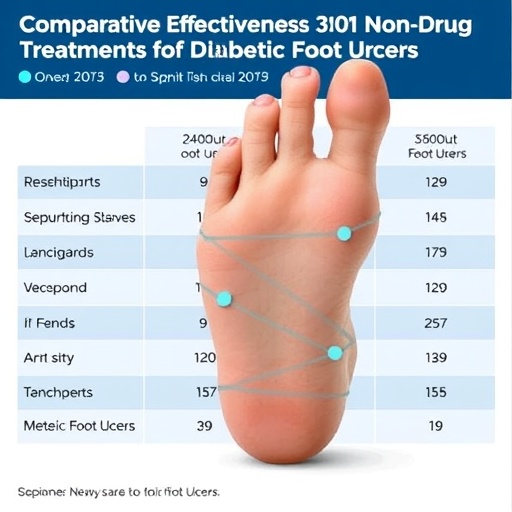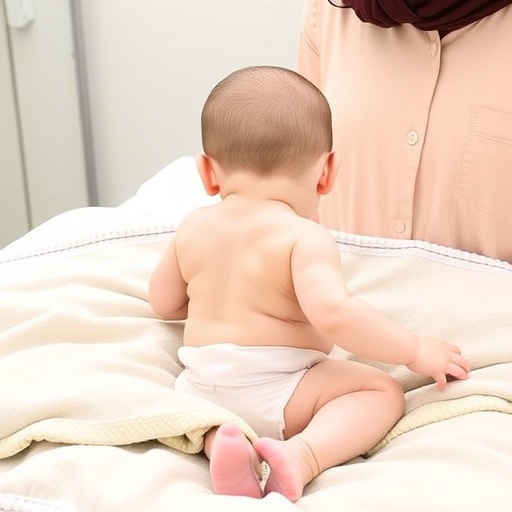In recent years, the management of diabetic foot ulcers (DFUs) has become an increasingly critical area of research, particularly given the rapid rise in diabetes prevalence globally. Individuals suffering from diabetes often face debilitating complications, and among the most challenging is the emergence of foot ulcers. For healthcare professionals focusing on non-pharmacological interventions, the need for a comprehensive evaluation of existing nursing strategies has never been more pressing. Therefore, a new systematic review and network meta-analysis has taken center stage, illuminating the comparative efficacy and safety of various non-pharmacological nursing interventions for diabetic foot ulcers.
This groundbreaking study, conducted by a team of researchers led by Gong et al., brings an unprecedented level of scrutiny to the available nursing interventions for diabetic foot ulcers. The research systematically evaluates and synthesizes data from multiple studies to develop a robust understanding of what methods work best in promoting ulcer healing and ensuring patient safety. The importance of such research lies not only in improving clinical outcomes but also in enhancing the quality of life for patients burdened with these chronic wounds.
The methodology employed in this systematic review is noteworthy for its rigor and comprehensiveness. The researchers meticulously gathered data from numerous databases, ensuring a wide-ranging collection of relevant studies. This holistic approach allows for a thorough comparison of different nursing interventions, encompassing both established practices and innovative techniques that may be on the cutting edge of wound care. By using a network meta-analysis, the study provides a comparative efficacy assessment of interventions that may not have been directly tested against each other in prior research.
Among the non-pharmacological interventions that were scrutinized in the study, several stand out due to their promising results. Techniques such as patient education, meticulous foot care routines, and the application of advanced dressing materials exemplify the proactive approaches that nursing staff can employ. These interventions not only address the immediate needs of ulcer care but also empower patients with the knowledge and skills necessary to manage their condition effectively. The significance of these findings resonates with nursing practitioners, as it highlights the essential role they play in patient-centered care.
One of the key insights gleaned from the analysis is the variation in efficacy among different nursing intervention strategies. While some approaches yielded more significant healing rates, others demonstrated improved safety profiles, suggesting that the choice of intervention may depend on individual patient circumstances. This nuanced understanding underscores the importance of personalized care plans tailored to the unique needs of each person with diabetes. Consequently, the findings are poised to inform clinical practice guidelines and enhance the decision-making process for healthcare providers.
Safety is equally paramount in the context of diabetic foot ulcer care, and the systematic review addresses this pivotal aspect comprehensively. By analyzing the safety outcomes associated with various interventions, the authors provide invaluable insights that can guide nurses and healthcare teams toward safer practices. This focus on safety is critical, particularly in populations with chronic conditions such as diabetes, where complications can arise swiftly if care is not managed appropriately.
As healthcare systems around the world are increasingly embracing evidence-based practices, the implications of this study extend beyond academic circles. The findings are likely to influence policy changes and resource allocation, as healthcare leaders recognize the necessity of investing in effective, evidence-based nursing interventions. The potential for improved patient outcomes can lead to significant reductions in healthcare costs associated with the treatment of diabetic foot ulcers.
Furthermore, the study’s emphasis on non-pharmacological strategies encourages a multidisciplinary approach to care. Collaboration among nursing, dietary, podiatric, and medical professionals is essential to comprehensively address the multifactorial nature of diabetic foot ulcers. By fostering cooperation among various disciplines, healthcare providers can create a holistic care environment that supports patients at every step of their healing journey.
The world of nursing is continuously evolving, and research such as that conducted by Gong et al. is vital for propelling the field forward. The meticulous analysis of non-pharmacological interventions not only enhances existing knowledge but also prompts further inquiry into new and emerging techniques. As future research builds upon these findings, nursing professionals will be better equipped to confront the challenges posed by diabetic foot ulcers.
In addition to clinical implications, the societal impact of this research cannot be overstated. The burden of diabetic foot ulcers is felt not merely by those suffering from them but also by families, communities, and healthcare systems. By promoting interventions that effectively reduce ulcer incidence and enhance healing, this research contributes to a broader narrative of improving public health and patient welfare.
While the study highlights the efficacy of specific nursing interventions, it also calls attention to gaps in the literature that future studies must address. For instance, further investigation into the longitudinal impacts of these interventions could yield insights into the long-term health trajectories of patients. Additionally, exploring the psychological dimensions of living with diabetic foot ulcers and how nursing interventions can address these needs remains an important avenue for future research.
Ultimately, Gong et al.’s study provides a critical stepping stone toward advancing nursing practices related to diabetic foot ulcers. By meticulously evaluating the efficacy and safety of non-pharmacological interventions, the research opens the door for innovative care strategies that can transform patient experiences. As healthcare continues to evolve, the integration of such evidence-based approaches will be vital in ensuring that individuals with diabetes receive the highest standard of care and support.
The future of diabetic foot ulcer management looks promising, thanks in part to the diligent efforts of researchers and nursing professionals committed to enhancing patient outcomes. By harnessing the power of systematic reviews and meta-analyses, the healthcare community is better prepared to meet the challenges posed by this common yet debilitating condition.
While ongoing research will undoubtedly continue to unearth new methodologies and discoveries, the principles established in the current study hold the potential for profound impacts in the realm of nursing care for diabetic foot ulcers. Embracing these evidence-based practices can pave the way for improved healing, better patient safety, and, above all, a brighter future for individuals grappling with diabetes-related complications.
Subject of Research: Non-pharmacological nursing interventions for diabetic foot ulcers.
Article Title: Comparative efficacy and safety of non-pharmacological nursing interventions for diabetic foot ulcers: a systematic review and network meta-analysis.
Article References:
Gong, J., Sun, X., Fu, H. et al. Comparative efficacy and safety of non-pharmacological nursing interventions for diabetic foot ulcers: a systematic review and network meta-analysis.
BMC Nurs 24, 1445 (2025). https://doi.org/10.1186/s12912-025-04065-x
Image Credits: AI Generated
DOI: https://doi.org/10.1186/s12912-025-04065-x
Keywords: Diabetic foot ulcers, non-pharmacological interventions, nursing care, systematic review, network meta-analysis, patient safety, wound healing.
Tags: chronic wound management techniquescomparative effectiveness research in healthcarediabetes complications and treatmentsdiabetic foot ulcer managementevidence-based nursing practicesnetwork meta-analysis in nursingnon-drug interventions for DFUsnursing strategies for ulcer healingpatient safety in diabetic foot carequality of life for diabetic patientsresearch on non-pharmacological interventionssystematic review of foot ulcer treatments





